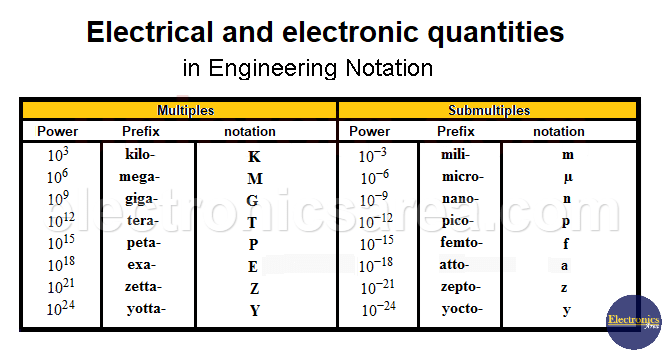Scientific – Engineering Notation
Scientific notation and engineering notation allow the representation of very large or very small quantities, very common in engineering and technical fields such as electricity and electronics, among others.
The difference between the two types of notation is the representation of the exponent.
- In scientific notation, the exponent can be any value.
- In engineering notation, it must always be a multiple of 3, and the multiplicative factor must be between 1 and 1000.
– Scientific notation for large numbers
A random number: 28 000 000 = 2.8 x 107
- 2.8 = is the multiplicative factor, which must always be less than 10
- 10 = base
- 7 = exponent
For example:
The weight of the Earth = 6,000,000,000,000,000,000,000,000 kilograms.
The weight of the Earth in scientific notation: 6 x 1024 kilograms. This number is much easier to read and understand than the previous one.
– Scientific Notation for Small Numbers
The charge of the electron is 0.00000000000000000016021766208 Coulomb (Coulomb). This number converted to engineering notation is: 1.6021766208×10-19 Coulombs. Much easier to read and understand.
Note that for large numbers the exponent is positive and for numbers between 0 and 1 the exponent is negative.
– Engineering notation
Engineering notation is similar to scientific notation, except that the exponent is expressed in multiples of 3. This is so that it matches the units commonly used. A x 10B.
Where “A” is the multiplicative factor that is between 1 and 1000. It is not necessary to put more zeros, as it is fixed by correcting the exponent.
And “B” is the exponent that is always a multiple of 3 (3, 6, 9, 12, etc.).
Note: when expressing numbers less than 1 (between 0 and 1) the exponent has a negative sign, e.g. 0.5 = 2-1 or the electron charge expressed above.
For example:
- 1 Kg = 1 x 103 grams
- 1 mm = 1 x 10-3 m
- 1 GB = 1 x 106 bytes
Nomenclature of basic electrical and electronic quantities in engineering notation
Below is a table of the most common multiples and submultiples. Note that powers are always multiples of 3.
Some examples of the use of engineering notation in electricity and electronics
Resistance / Resistance (Ω)
- 1 Kilohm = 1 x 103 ohms
- 10 Megohms = 10 x 106 ohms
- 3.9 Gigaohm = 3300000000 ohms = 3.9 x 109 ohms
Electric Current (A)
- 5 milliamps (5 mA) = 5 x 10-3 amps
Voltage / Electrical Voltage (V)
- 9 millivolts (9 mV) = 9 x 10-3 volts
- 12 kilovolts (12 kV) = 12 x 103 volts
Capacitor (F)
- 470 microfarads (470 µF) = 470 x 10-6 farads
- 22 nanofarads (22 nF) = 22 x 10-9 farads
Inductor / Coil (H)
- 15 millihenries (15 mH) = 15 x 10-3 henries
Power (W)
- 500 milliwatts (500 mW / mWatts) = 500 x 10-3 watts

